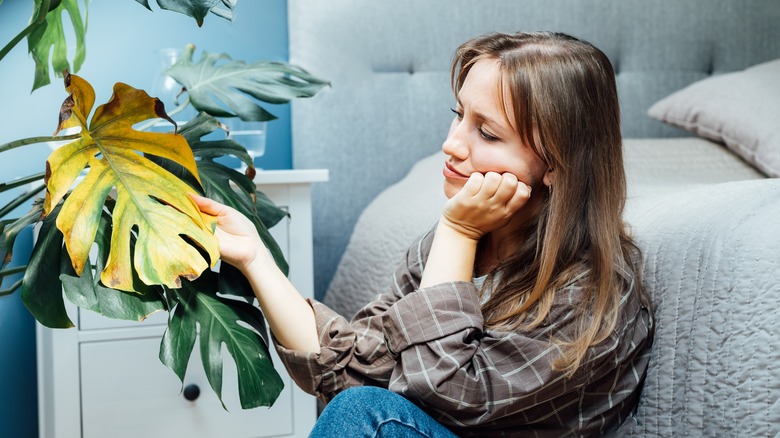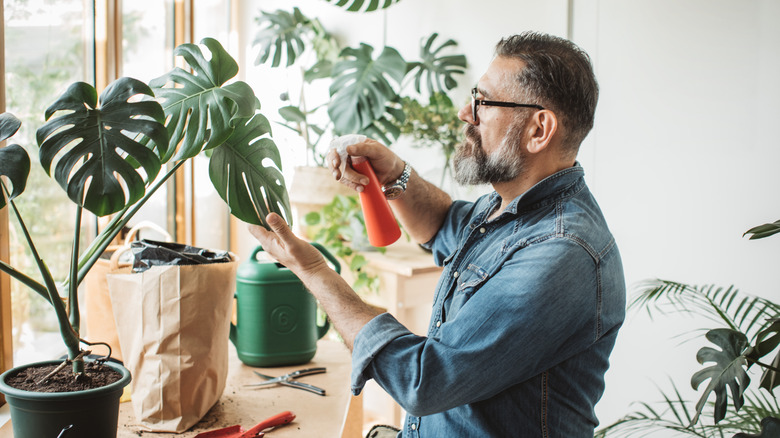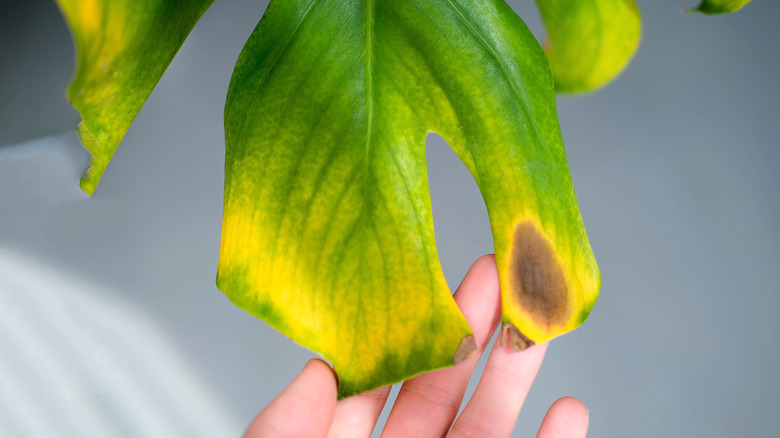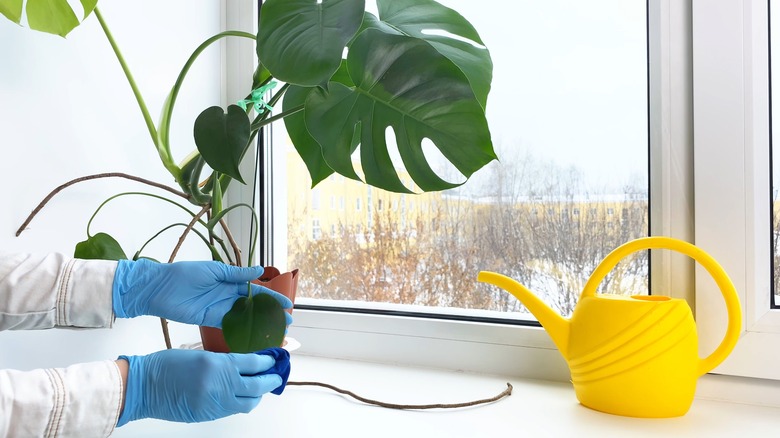Here's How To Fix A Floppy Monstera Plant
While monstera plants are popular for their low-maintenance nature and hardiness, many people find the leaves or stems of their plants becoming floppy or droopy over time. This is often due to a variety of reasons, the most common being overwatering, underwatering, or lack of sunlight. Under the right conditions of bright, indirect sunlight every day in combination with regular watering every week, most monsteras can be expected to thrive. That's why a floppy appearance in the leaves of the plant is usually an indication that there is an issue with either water levels or sun exposure.
The first step in fixing a floppy-looking monstera plant is figuring out exactly what it is that made it that way in the first place. This will allow you to correct the growing conditions that led to it becoming droopy, which can help your plant perk back up and prevent it from happening again. Fortunately, it's usually fairly easy to diagnose the cause of a floppy monstera.
If your monstera is floppy from underwatering
If you notice your normally perky monstera plant beginning to droop, there's a good chance you may not be giving it enough water, to which the simple solution is to quench its thirst — and subsequently increase the amount and/or frequency you are watering your plant going forward.
To test whether or not your monstera is getting enough water, stick your finger into the soil. If the soil doesn't feel wet beyond the top couple of inches, odds are, your plant isn't getting enough water. If you find this to be the case, thoroughly soak the soil, making sure it's able to drain properly. Continue to do this every time you notice that the soil feels dry.
If you notice your monstera's soil is extremely dry and in need of a good soak, you can douse it in water from overhead or submerge it in water at the base. Submerging the base of your plant in water is your best option if the soil has become so dry that it has become compact. To water from overhead, slowly pour water into the soil, letting the standing water fully absorb before adding more. If you choose to water from the other end, fill a big basin halfway with water and let your plant sit in the water for anywhere from 10 to 20 minutes. If the cause of your floppy monstera is underwatering, ensuring its soil never dries out should correct and prevent the issue in the future.
If your monstera is floppy from overwatering
Just as underwatering your monstera plant can make it look floppy, so too can overwatering it. Though it's true monstera are generally hardy, low-maintenance plants, they still have their limits and are susceptible to overwatering just like any other plant. As a general rule of thumb, you shouldn't water your monstera more than once a week. Clear signs of an overwatered monstera are yellowed leaves, or, in severe cases, dark brown soggy spots on the leaves, so if your floppy monstera also has any of these symptoms, there's a good chance it's being watered too frequently.
If you aren't watering your monstera too frequently and it's still showing telltale symptoms of overwatering or you notice an excessive amount of moisture in the soil, it's equally likely that either the pot or the soil your monstera is planted in is retaining too much water and not allowing it to drain properly. It's important to make sure your monstera is planted in a pot that has drainage holes, which allow extra water to freely flow from the soil. These drainage holes are key when it comes to fixing and preventing a floppy monstera, so if your monstera is currently planted in a pot without them, upgrade to one that has them. If your monstera is in a pot with drainage holes and the soil is still retaining excess water, it's possible the soil you planted it in is simply too dense to allow proper drainage.
If your monstera is floppy from lack of sunlight
Another common cause of a floppy-looking monstera is lack of the right sunlight. While monstera are popular houseplants because they are considered relatively easy to grow, they still need plenty of indirect sunlight. One of the first indications that your monstera is not receiving the right amount or type of sunlight is a floppy appearance.
If the leaves of your monstera plant are beginning to look floppy and it isn't in an area of your home that receives eight hours of indirect light every day, it's safe to assume your plant isn't in the right spot. If you detect lack of sunlight to be the main cause of your floppy monstera, the simple solution is to move the plant to an area that gets more light on a daily basis. Putting your monstera plant in front of a window that faces east is the most ideal option if that is one available to you, as east-facing windows let in a lot of bright light without the sun's rays ever shining too directly on your plant. If you do not have any east-facing windows where you can put your monstera, putting it in front of a window that faces south or west is the next-best option — as long as you make sure the rays your plant is receiving are not too direct or harsh. If you can't avoid direct rays, consider filtering the harshness with a sheer curtain. As a last resort, if you don't have access to any areas with the right type of lighting, monstera plants also respond well to artificial indoor growth lights.



